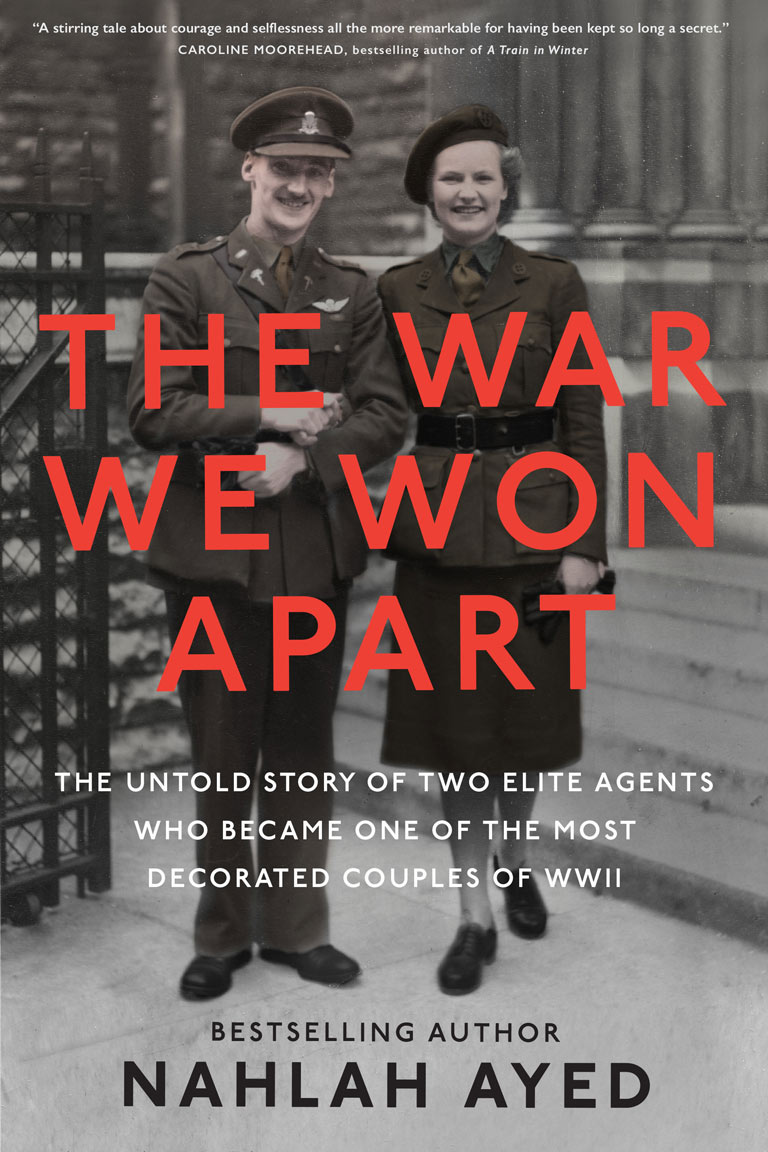The War We Won Apart

The War We Won Apart: The Untold Story of Two Elite Agents Who Became One of the Most Decorated Couples of WWII
by Nahlah Ayed
Viking
416 pages, $36
Superficially, this book is a love story. On the cover is a photograph of a good-looking man and woman, with arms linked and glorious smiles on their faces, while the subtitle is The Untold Story of Two Elite Agents Who Became One of the Most Decorated Couples of WWII. The two are Sonia Butt and Guy d’Artois, both of whom served in Britain’s Special Operations Executive (SOE). They prove to be spectacular heroes, but they come alive because author Nahlah Ayed explores their incredible bravery as well as their flaws, both during and after the war.
There is more than romance in The War We Won Apart. Ayed has also given us a glimpse of what the SOE did, behind German lines, from 1940 to 1945. British Prime Minister Winston Churchill called this motley corps of incredibly brave men and women his secret army; many of its activities within occupied France remain unrecorded, but they included espionage, sabotage, and reconnaissance. The SOE’s personnel and supplies would prove immeasurably helpful to French resistance fighters, the Maquis, shortening the war by weeks if not months.
If there had been no war, Butt and d’Artois would never have met; they came from different continents. What they had in common was bilingual fluency and ardent natures.
Sonia Butt, a nervy tomboy, was English but had spent a miserable childhood shuttling between her mother in France and her father in England. In 1941, on her seventeenth birthday, she walked into London’s Moss Brothers Clothiers, where she tried on the uniforms of the Women’s Auxiliary Air Force, the Women’s Royal Naval Service, and the Auxiliary Transport Service, then the only options for women who wanted to serve in the armed forces. She decided that the WAAF uniform suited her best, so she next lined up at the WAAF recruitment centre. Butt noted that behind her was Prime Minister Churchill’s daughter Sarah, and ahead of her was a person whom she described as “a Piccadilly Commando” — a prostitute. Ayed notes that, “In a society obsessed with class, war had become an equalizer.”
For the next two years, Butt found herself doing dead-end clerical work — until her fluency in French won her the chance to serve in a much more dangerous capacity, behind enemy lines in France. Ignorant of what this might entail, the nineteen-year-old jumped at the idea.
With 7 uniquely curated newsletters to choose from, we have something for everyone.
Guy d’Artois was the son of a Quebec lawyer who had fallen on hard times. In 1939, when Britain and Canada declared war on Germany, twenty-one-year-old d’Artois, “a slight, wiry thunderstorm of a man,” volunteered immediately and was soon on a troopship to England. For the next four years, he zigzagged through various jobs, acquiring a reputation as almost recklessly courageous and potentially a strong leader. A natural SOE recruit, he was looking for adventure and had a far better idea than Butt of the risks that lay ahead.
The two young agents met during the initial SOE training course in Scotland, while being assessed for physical and psychological strength and being taught how to survive alone in the field. Having served as a paratrooper, d’Artois scored top marks for parachute jumps; Butt learned to outshoot most of the men (being ambidextrous helped her). However, the shortcomings of both recruits were noted: Guy d’Artois was described as “restless, impulsive … self-centred and ruthless in his relations with others,” while Sonia Butt was assessed as “wholesome and full of animal vitality … interested in men and susceptible to their attentions.”
They were soon inseparable, and within weeks they were married. To their consternation, SOE authorities decreed that, as a result, they should never serve in the same underground network in France.
Both jumped to their different destinations only a month later. Their task was the same: to enable a sabotage campaign that would hamper German forces from responding to an Allied landing from D-Day forward. Ayed’s account of their exploits is riveting spy-novel material, especially when one considers the thirteen women and ninety-one men working for the SOE in France who died after being tortured, shot, executed, and/or imprisoned in concentration camps. In the Charolles region, Guy would help to train and to equip three battalions. As a courier who cycled between Maquis cells, Sonia was exposed to constant danger. At one point she was raped by two German soldiers.
For her narrative, Ayed relies heavily on a memoir prepared by Sonia Butt d’Artois, but she also provides a much larger story by vividly contextualizing each incident. Thanks to careful mining of military archives and extensive research from secondary sources, the personalities and exploits of the d’Artoises have been made into the backbone of this book, while the information it reveals about the SOE is fascinating. Ayed, already well-known in Canada as an award-winning CBC journalist, has produced a page-turner.
We hope you’ll help us continue to share fascinating stories about Canada’s past by making a donation to Canada’s History today.
We highlight our nation’s diverse past by telling stories that illuminate the people, places, and events that unite us as Canadians, and by making those stories accessible to everyone through our free online content.
Canada’s History is a registered charity that depends on contributions from readers like you to share inspiring and informative stories with students and citizens of all ages — award-winning stories written by Canada’s top historians, authors, journalists, and history enthusiasts.
Any amount helps, or better yet, start a monthly donation today. Your support makes all the difference. Thank you!
Themes associated with this article
Advertisement
Save as much as 52% off the cover price! 6 issues per year as low as $29.95. Available in print and digital.




